Related Research Articles
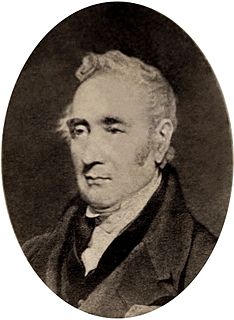
George Stephenson was a British civil engineer and mechanical engineer. Renowned as the "Father of Railways", Stephenson was considered by the Victorians a great example of diligent application and thirst for improvement. Self-help advocate Samuel Smiles particularly praised his achievements. His chosen rail gauge, sometimes called "Stephenson gauge", was the basis for the 4 feet 8+1⁄2 inches (1.435 m) standard gauge used by most of the world's railways.

Stephenson's Rocket is an early steam locomotive of 0-2-2 wheel arrangement. It was built for and won the Rainhill Trials of the Liverpool and Manchester Railway (L&MR), held in October 1829 to show that improved locomotives would be more efficient than stationary steam engines.

The Liverpool and Manchester Railway (L&MR) was the first inter-city railway in the world. It opened on 15 September 1830 between the Lancashire towns of Liverpool and Manchester in England. It was also the first railway to rely exclusively on locomotives driven by steam power, with no horse-drawn traffic permitted at any time; the first to be entirely double track throughout its length; the first to have a true signalling system; the first to be fully timetabled; and the first to carry mail.

William Huskisson was a British statesman, financier, and Member of Parliament for several constituencies, including Liverpool.

Joseph Locke FRSA was a notable English civil engineer of the nineteenth century, particularly associated with railway projects. Locke ranked alongside Robert Stephenson and Isambard Kingdom Brunel as one of the major pioneers of railway development.
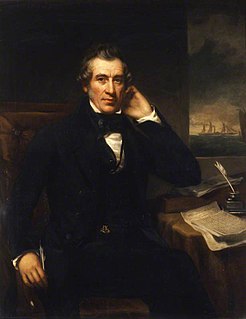
Sir William Fairbairn, 1st Baronet of Ardwick was a Scottish civil engineer, structural engineer and shipbuilder. In 1854 he succeeded George Stephenson and Robert Stephenson to become the third president of the Institution of Mechanical Engineers.
Francis Giles (1787–1847) was a canal engineer and surveyor who worked under John Rennie and later became a railway engineer.
The Bolton and Leigh Railway (B&LR) was the first public railway in Lancashire, it opened for goods on 1 August 1828 preceding the Liverpool and Manchester Railway (L&MR) by two years. Passengers were carried from 1831. The railway operated independently until 1845 when it became part of the Grand Junction Railway.

Henry Booth was a British corn merchant, businessman and engineer particularly known as one of the key people behind the construction and management of the pioneering Liverpool and Manchester Railway (L&M), the world's first steam railway conducting both scheduled passenger services and freight.
Thomas Longridge Gooch was civil engineer of the Manchester and Leeds Railway from 1831 to 1844.

William James was an English lawyer, surveyor, land agent and pioneer promoter of rail transport. According to his obituary "He was the original projector of the Liverpool & Manchester and other railways, and may with truth be considered as the father of the railway system, as he surveyed numerous lines at his own expense at a time when such an innovation was generally ridiculed."
Charles Pascoe Grenfell was a British businessman and Liberal Party politician.
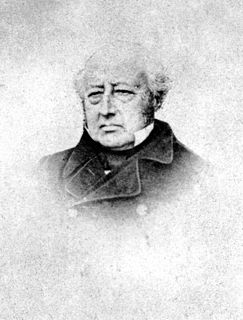
Edward Bury was an English locomotive manufacturer. Born in Salford, Lancashire, he was the son of a timber merchant and was educated at Chester.

The Liverpool and Manchester Railway (L&M) opened on 15 September 1830. Work on the L&M had begun in the 1820s, to connect the major industrial city of Manchester with the nearest deep water port at the Port of Liverpool, 35 miles (56 km) away. Although horse-drawn railways already existed elsewhere, the Stockton and Darlington Railway had been running for five years, and a few industrial sites already used primitive steam locomotives for bulk haulage, the L&M was the first locomotive-hauled railway to connect two major cities, and the first to provide a scheduled passenger service. The opening day was a major public event. Arthur Wellesley, Duke of Wellington, the prime minister, rode on one of the eight inaugural trains, as did many other dignitaries and notable figures of the day. Huge crowds lined the track at Liverpool to watch the trains depart for Manchester.

Lawrence Heyworth was a merchant based in Liverpool, England, who served as a Member of Parliament (MP) for Derby.
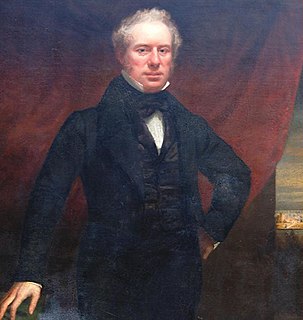
Adam Hodgson (1788–1862) was an English merchant in Liverpool, known also as a writer and abolitionist.
John Ashton YatesFRSA was a British Whig politician and railroad investor.
James Cropper (1773–1840) was an English businessman and philanthropist, known as an abolitionist.
Charles Lawrence was a Liverpool merchant who served as Mayor of Liverpool in 1823–4. He is primarily remembered as Chairman of the Liverpool & Manchester Railway which opened in 1830.
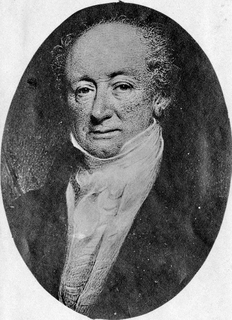
Sir John Tobin (1763–1851) was a Manx merchant based in Liverpool. He was a merchant seaman who became a sea captain, making voyages both as a slave trader and as a privateer against French shipping. He was Mayor of Liverpool in 1819–1820. In later life he was involved in canal and railway development.
References
- ↑ Sandars, John. "Sandars Centuries". Sandars: now and then. Retrieved 30 June 2017.
- ↑ Sandars, Joseph (1833). "Report from the Select Committee on Agriculture". Google Books. Retrieved 30 June 2017.
- ↑ "A copious report of the inquiry into the affairs of Liverpool Corporation". Google Books. 1833. Retrieved 30 June 2017.
- ↑ "History of Parliament Online" . Retrieved 30 June 2017.
- ↑ Sandars, Joseph (1824). "A Letter Addressed to the Liverpool Society for the Abolition of Slavery". Google Books. Retrieved 23 August 2019.
- ↑ "Slavery". Cornell University. Retrieved 30 June 2017.
- ↑ Morris, Edward (1999). "The formation of the Gallery of Art in the Liverpool Royal Institution, 1816-1819". Transactions of the Historical Society of Lancashire & Cheshire. 142.
- ↑ LNWR Roll of the directors of the company. 1849. hdl:2027/mdp.39015020923481.
- ↑ Gambardella, Spiridione. "Three wise men". Edge Hill Station. METAL. Retrieved 30 June 2017.
- ↑ James, William. "Oculine Survey of Investigation". National Archives. Retrieved 18 July 2017.
- ↑ Cheshire Marriage licence bonds and allegations 1606-1905
- ↑ Derby Mercury, 28 April 1830 p. 3
- ↑ Derby Mercury 11 June 1834 p. 3
- ↑ London Evening Standard p.4
- ↑ "Ecclesiastical Gazette". 1843.
- ↑ Dell, Alan. "Joseph Sandars, Quaker" (PDF). Buckinghamshire Family History Society. Retrieved 18 July 2017.